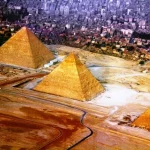Giza City

Giza City
Giza city is the capital of Giza governorate. Officially, it was founded in the fourth century BC. It was probably a small village since ancient times of Egyptian history. It located in the center of the way between Heliopolis and Memphis on the western bank of the Nile. The large capital “Memphis” was the southern city of current Giza. Memphis was a major cultural and commercial center throughout the time of Ancient Egyptian history. When Christianity flourished in Egypt, Memphis lost much of its importance.
After the Islamic conquest, Memphis was abandoned, but Giza received more value. It was well-fortified by orders of the commander of the troops of the Arab conquest Amr Ibn Al-As. Great mosques were built at Giza, but unfortunately, there was nothing left of them. Most of this area was agricultural lands, and still has a considerable part of vegetation and agriculture activities. Further, it was a target of floods of the Nile throughout its history, especially in the low lands. For centuries, Giza was just a small town and it surrounded by rural villages and small communities of farmers and fishermen.
In the 19th century the governor of Egypt Ismael Pasha built a great palace surrounded by beautiful gardens in Giza. From 1889 to 1902, an annex to this palace transformed temporarily into a museum of Egyptian antiquities discovered at that time. When the works of the Egyptian Museum in Tahrir square finished, the collection of Giza museum transferred to the new museum in Cairo center. Later, the palace gardens transformed into two of the most important public gardens in the city of Giza and the whole area of Greater Cairo; “The Orman Botanical Gardens” and “Giza Zoo”.
Giza in Contemporary Era
In 1869, the Suez Canal opened in an atmosphere of large and pompous ceremonies in the presence of the governor of Egypt Ismael Basha together with international guests and great figures, monarchs, princes, princesses, dukes and ministers from around the world, and above all came Empress of France Eugenie, the wife of the French Emperor Napoleon III. Therefore, massive scheme of public works planned and carried out, buildings, reconstructions, decorations and maintenance accomplished in order to facilitate transportation and visits of high guests, particularly to the historical sites, and thus was born the project “Avenue of the Pyramids” in Giza. Later the area extended to the north and west.
New districts appeared with Schools, hotels, restaurants, banks, schools and commercial establishments. In the early 20th century the ambitious project of the University of Cairo was born. A land located near of the western bank of the Nile. Further, the government chose to be the New Cairo University. But actually and geographically it is in the land of the city of Giza. This university is the Mother University not only in Egypt but also in the Arab and African world.
Then many embassies built in the city, especially in the city center and El Duqqi neighborhood. For geographic and demographic reasons, today the city of Giza is a part of Greater Cairo, but administratively are two separate provinces and each has its independent mayor and council: Greater Cairo contains the entire Cairo, most of Giza and a part of Al-Qalyubia province located in the north of the present Cairo. This region has about 20 million inhabitants.
Diversity of Giza monuments
Most of the monuments of Giza is ancient Egyptian. On the other hand, the Islamic Monuments and Ancient Christians are rare in the city; that on the contrary of Cairo that has most of the Islamic and Christian Coptic Monuments in the Egyptian territory. It has few Ancient Egyptian historical sites.
In fact, among the most important historical sites of Giza there are: Sakkara, the vast necropolis of the great ancient capital Memphis containing varieties of monuments, pyramids above the king’s Zoser Step Pyramid; a large number of Mastabas, decorated tombs of ancient nobles whose themes show fantastic scenes of everyday life of the ancient Egyptians. Serapium is large underground galleries where the sacred bulls (Apis) buried within giant granite sarcophagi. Giza also contains the ruins of the ancient capital Memphis. There are also other important historical sites in the province as Dahshour, Abou Sir, Atfih and Abou Rawash ; but Bahareya is very far from the border of Giza town, about 380 km in the Western desert. The most important area is the one of the pyramids in Giza plateau which contains the great Pyramids; Quóps, Qufrén and Mequerinos, besides the Sphinx.





